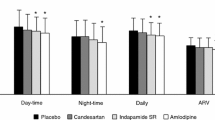Abstract
Effective treatment of high blood pressure represents a key strategy for reducing the burden of hypertension-related cardiovascular diseases, mostly myocardial infarction and stroke. Despite these well established concepts, however, hypertension remains poorly controlled, worldwide. In addition, treated hypertensive patients often remain at higher risk compared with the normotensive population, even when a satisfactory blood pressure control is achieved, due to the high or very high added cardiovascular risk profile observed in these patients.
An emerging strategy to improve blood pressure control and achieve this unmet target for cardiovascular disease prevention in hypertensive patients is represented by a more extensive use of rational and effective combination therapies with respect to monotherapy. Such an approach has been recently proposed even as first-line strategy in hypertensive patients at high added cardiovascular risk or in those in whom strict blood pressure control is required.
Within the possible antihypertensive drug combinations currently available for the clinical management of hypertension, those based on the association of drugs inhibiting the renin-angiotensin system and thiazide diuretics or calcium channel blockers have demonstrated to be effective and safe in lowering both systolic and diastolic blood pressure levels with a good tolerability profile. In addition, these strategies have provided evidence for effective cardiovascular protection compared with conventional antihypertensive therapies.
Among the antihypertensive drugs able to counteract the deleterious effects of abnormal activation of the renin-angiotensin system, angiotensin II receptor blockers have demonstrated to provide better tolerability profile and greater cardiovascular protection on hypertension-related organ damage compared with ACE inhibitors in randomized controlled clinical trials, in the presence of similar antihypertensive efficacy and safety. In particular, these drugs are characterized by lower rates of drug-related side effects, better compliance and adherence to prescribed antihypertensive regimens, and use in synergistic and rational combination therapies, all factors that may contribute to improve blood pressure control and reduce discontinuations from antihypertensive therapy in treated hypertensive patients.

Similar content being viewed by others
References
Mancia G, De Backer G, Dominiczak A, et al. for the Task Force for the Management of Arterial Hypertension of the European Society of Hypertension (ESH) and of the European Society of Cardiology (ESC). Management of arterial hypertension. 2007 Guidelines for the management of arterial hypertension. J Hypertens 2007; 25 (6): 1105–87.
Mancia G, Sega R, Milesi C, et al. Blood-pressure control in the hypertensive population. Lancet 1997; 349: 454–7.
Mancia G, Pessina AC, Trimarco B, et al., SILVIA (Studio Italiano Longitudinale sulla Valutazione della Ipertensione Arteriosa nel 2000) Study Group. Blood pressure control according to new guidelines targets in low- to high-risk hypertensives managed in specialist practice. J Hypertens 2004; 22 (12): 2387–96.
Mancia G, Laurent S, Agabiti-Rosei E, et al., European Society of Hypertension. Reappraisal of European guidelines on hypertension management: a European Society of Hypertension Task Force document. J Hypertens 2009; 27: 2121–58.
Monane M, Bohn RL, Gurwitz JH, et al. The effects of initial drug choice and comorbidity on antihypertensive therapy compliance: results from a population-based study in the elderly. Am J Hypertens 1997; 10 (Pt 1): 697–704.
Gerbino PP, Shoheiber O. Adherence patterns among patients treated with fixed-dose combination versus separate antihypertensive agents. Am J Health Syst Pharm 2007; 64: 1279–83.
Dickson M, Plauschinat CA. Compliance with antihypertensive therapy in the elderly: a comparison of fixed-dose combination amlodipine/benazepril versus component-based free-combination therapy. Am J Cardiovasc Drugs 2008; 8 (1): 45–50.
Bramley TJ, Gerbino PP, Nightengale BS, et al. Relationship of blood pressure control to adherence with antihypertensive monotherapy in 13 managed care organizations. J Manag Care Pharm 2006; 12: 239–45.
Sokol MC, McGuigan KA, Verbrugge RR, et al. Impact of medication adherence on hospitalization risk and healthcare cost. Med Care 2005; 43: 521–30.
Bangalore S, Kamalakkannan G, Parkar S, et al. Fixed-dose combinations improve medication compliance: a meta-analysis. Am J Med 2007; 120: 713–9.
Gupta AK, Arshad S, Poulter NR. Compliance, safety, and effectiveness of fixed-dose combinations of antihypertensive agents: a meta-analysis. Hypertension 2010; 55: 399–407.
Acknowledgements
No sources of funding were used to assist in the preparation of this article. The author has no conflicts of interest that are directly relevant to the content of this article.
Author information
Authors and Affiliations
Corresponding author
Rights and permissions
About this article
Cite this article
Taddei, S. Fixed-Dose Combination Therapy in Hypertension. High Blood Press Cardiovasc Prev 19, 55–57 (2012). https://doi.org/10.1007/BF03262454
Received:
Accepted:
Published:
Issue Date:
DOI: https://doi.org/10.1007/BF03262454




